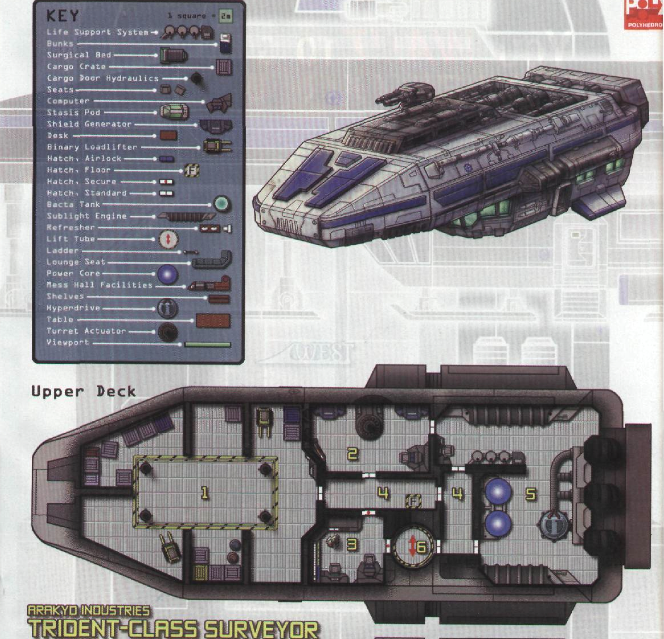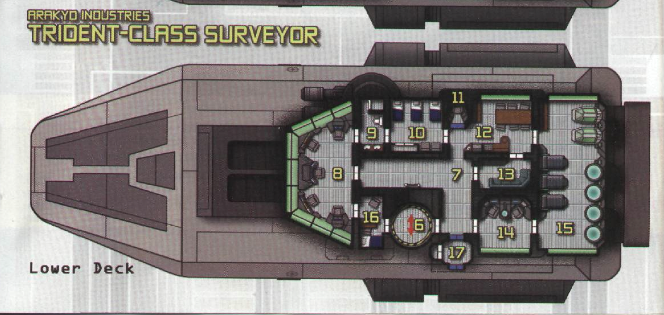The Trident-class surveyor ship, a product of Arakyd Industries, served as a scout vessel during the Galactic Civil War. Its primary function was long-duration, deep-space exploration coupled with planetary surveying.

Sporting a unique configuration, the Trident measured 82.5 meters in length, featuring a hull reinforced to withstand underwater pressures up to 10,000 meters. The upper deck, the only one extending the full length, allocated roughly half of its forward-protruding section to a specialized cargo hold. This aquatic-operations cargo bay incorporated powerful pressure regulation and circulation systems, preventing flooding even at extreme depths, effectively transforming it into a mobile diving facility and underwater airlock. A hydraulically operated floor hatch served as a cargo elevator, positioned for optimal visibility from the command deck, streamlining the loading of exploration vehicles and cargo during underwater operations.
The remaining space on the upper deck accommodated a portside weapons array, a concealed starboard electronics suite, and an engineering section at the rear. The portside weapons array was directly linked to the ship's offensive and defensive systems, enabling independent operation of the double turbolaser turret, shields, and mine deployment system via a computer console, bypassing the cockpit controls. This suite also provided direct access to the weapon systems' mechanics and the turbolaser's hydraulics, along with ceiling-mounted racks supplying seismic charges to the mine layer.
The hidden electronics suite occupied the starboard side of the upper deck. Concealed behind pressure-sensitive false walls and shielded against sensor detection, this compartment was exceptionally well-hidden. Its main purpose was to house the ship's extensive primary processors (necessary for research) and the sophisticated computer systems supporting the advanced artificial intelligence (AI), as well as providing refuge for the entire crew if required.
The AI, a sophisticated droid personality, possessed both a scientific curiosity and unwavering loyalty to the crew. Granted unrestricted access to all ship systems, the AI primarily managed the vast amounts of sensor data collected during exploration missions. A "kill-switch" phrase was programmed for emergencies, deactivating the AI and reverting control to manual operation. Due to the sensitive data stored by the AI, access to the suite was restricted to two entrances: one controlled by the AI (via the turbolift panel) and the other via a cleverly disguised computer terminal with a "pressure"-based manual override. The first entrance was located in the main hallway of the upper deck, near the emergency access hatch (a pressurized ladder connecting the decks), while the second was at the top of the ship's turbolift, providing rapid access from the captain's cabin.
The expansive aft engineering section provided access to the port and starboard sublight engines and housed all the vessel's power and propulsion systems. A pair of interconnected power cores supplied energy to the power-hungry ship, while a computer terminal allowed engineers to monitor all critical systems from a single station. Utilizing Sedrian technology, the Trident's propulsion systems were designed for operation in aquatic environments, reflecting the vessel's advanced and specialized nature.

Substantially shorter than the upper deck, the lower deck housed the command deck, crew quarters, captain's quarters, a large multi-person refresher, a crew lounge, mess hall, a computer lab, and a sizable medical/science lab.
The command deck was unusually positioned in an "under slung" configuration to provide the crew with a view of the ocean floor during underwater cruising, protect them from enemy fire, facilitate cargo loading, and assist in retrieving research probes. Spacious and well-equipped, the command deck monitored the ship's vital systems and operated its research-grade sensors, capable of penetrating water and other obstructions to deliver detailed analyses. Accommodating up to five individuals with personal consoles, the command deck featured large, reinforced transparisteel windows for enhanced visibility. It could also function as a "life boat" by sealing itself off and activating a self-contained life support system providing 48 hours of air. Designed to float to the surface in underwater emergencies, this feature also worked in space, although without propulsion, the ship's escape pod was generally a better option.
The starboard side housed the crew cabins, a single room containing three triple bunks. Accommodating nine crew members, the quarters were cramped; often, some bunks were stowed in the ceiling to provide more space and comfort for six crew members. Adjacent to the crew cabins was the ship's sole refresher, a large multi-person facility capable of accommodating several crew members simultaneously.
Located between the crew quarters and mess hall on the starboard side was the [escape pod](/article/escape_pod-legends]. Specialized for underwater use, the pod contained one seat and a week's worth of rations, although up to three adults could squeeze in. Equipped with atmospheric regulators to counteract pressure, the pod was designed to rapidly ascend to the surface when deployed underwater. Aft starboard was the mess hall, a room large enough to accommodate the entire crew, with storage cabinets in the ceiling and walls for food and rations. The mess hall connected to the crew lounge amidships, which featured a sofa and a wall-mounted entertainment center for crew relaxation.
The captain's cabin, located near the command deck and accessible via a single door, was small but well-appointed, providing privacy and easy access to both the command deck and a secondary door leading directly to the turbolift. Also on the port side was the ship's airlock. When closed, the airlock was protected by an angled section of hull plating that folded down to form steps to the hatch. Inside, a storage locker contained flight suits, breath masks, and glowrods for extravehicular activity, as well as a tool kit and any weapons the crew wished to store. A built-in decontamination shower helped seal the ship's interior against external contagions and pathogens, maintaining a sterile research environment.
Amidships on the port side was a computer lab where two technicians could work at terminals hardwired to the ship's central processors in the hidden electronics suite. Specialized for scientific analysis, the lab excelled at processing data and research, often working in conjunction with the aft science lab.
Located aft on the lower deck was the medical suite/science lab. This large room contained four bacta tanks, three surgical/examination beds, a pair of stasis pods, and shelving stocked with medical kits, [med packs](/article/medpac-legends], and surgery kits, effectively functioning as both the ship's medical facility and a research laboratory. The advanced facilities were also used to examine and preserve biological samples for research, with the lab collaborating with the computer lab to process raw data from exploration.
Arakyd sought to fill a perceived gap among existing freighters and starfighters by creating a specialized exploration vessel for surveying hostile environments inaccessible to other ships. The result was a long-range reconnaissance vessel incorporating a remarkable array of advanced technology for the most demanding exploration missions. However, this technology and innovation made the Trident one of the most expensive scout starships available.